Cultural Dimension Analysis of Canada and India
VerifiedAdded on 2022/11/13
|10
|1797
|469
AI Summary
This report explores the cultural dimensions of the country India and Canada, to help World Adventures tour operator with their business negotiation to avoid any conflicts with International Travel agency from India. Hofstede’s cultural dimension model is used to analyze and represent this study.
Contribute Materials
Your contribution can guide someone’s learning journey. Share your
documents today.
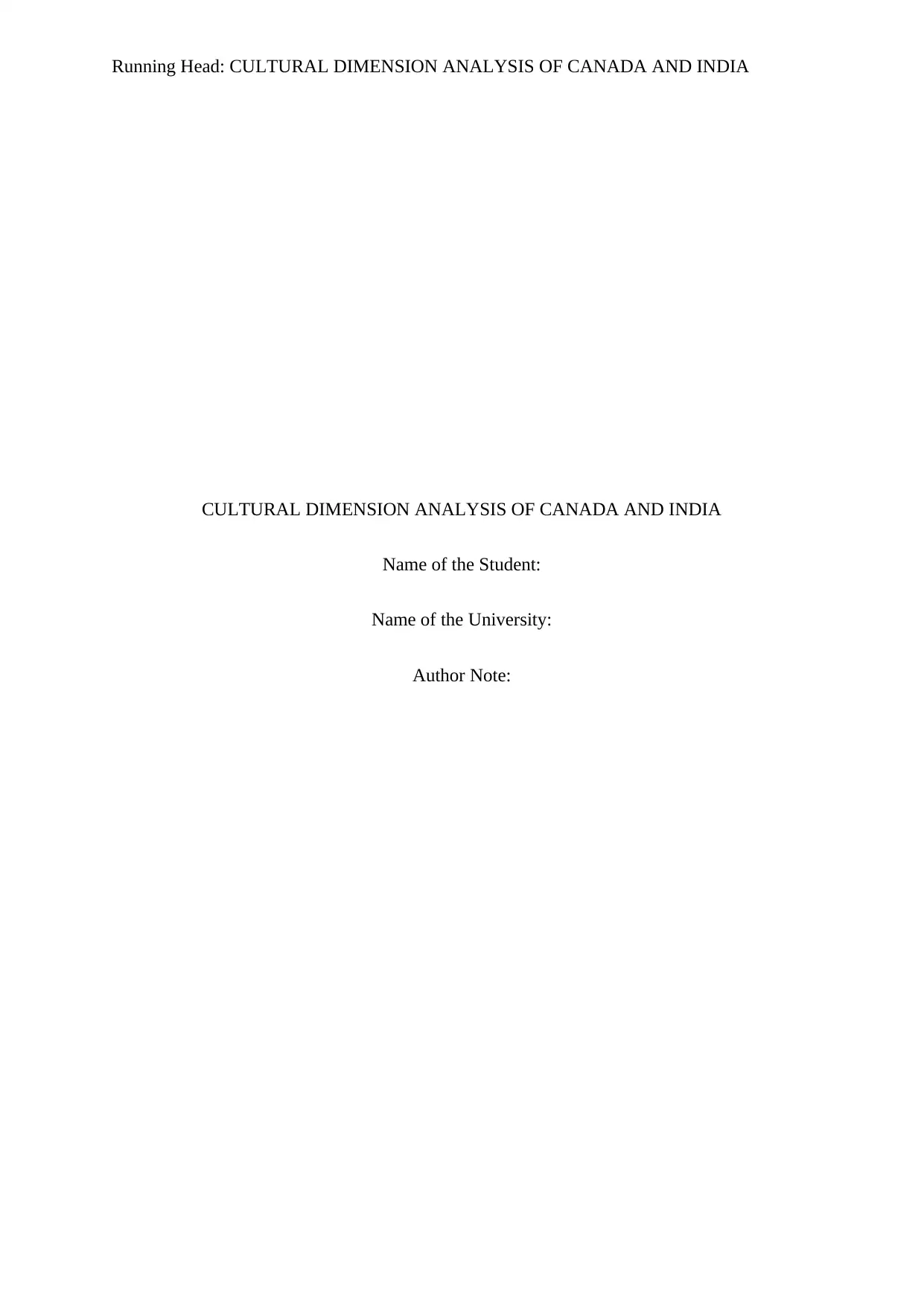
Running Head: CULTURAL DIMENSION ANALYSIS OF CANADA AND INDIA
CULTURAL DIMENSION ANALYSIS OF CANADA AND INDIA
Name of the Student:
Name of the University:
Author Note:
CULTURAL DIMENSION ANALYSIS OF CANADA AND INDIA
Name of the Student:
Name of the University:
Author Note:
Secure Best Marks with AI Grader
Need help grading? Try our AI Grader for instant feedback on your assignments.
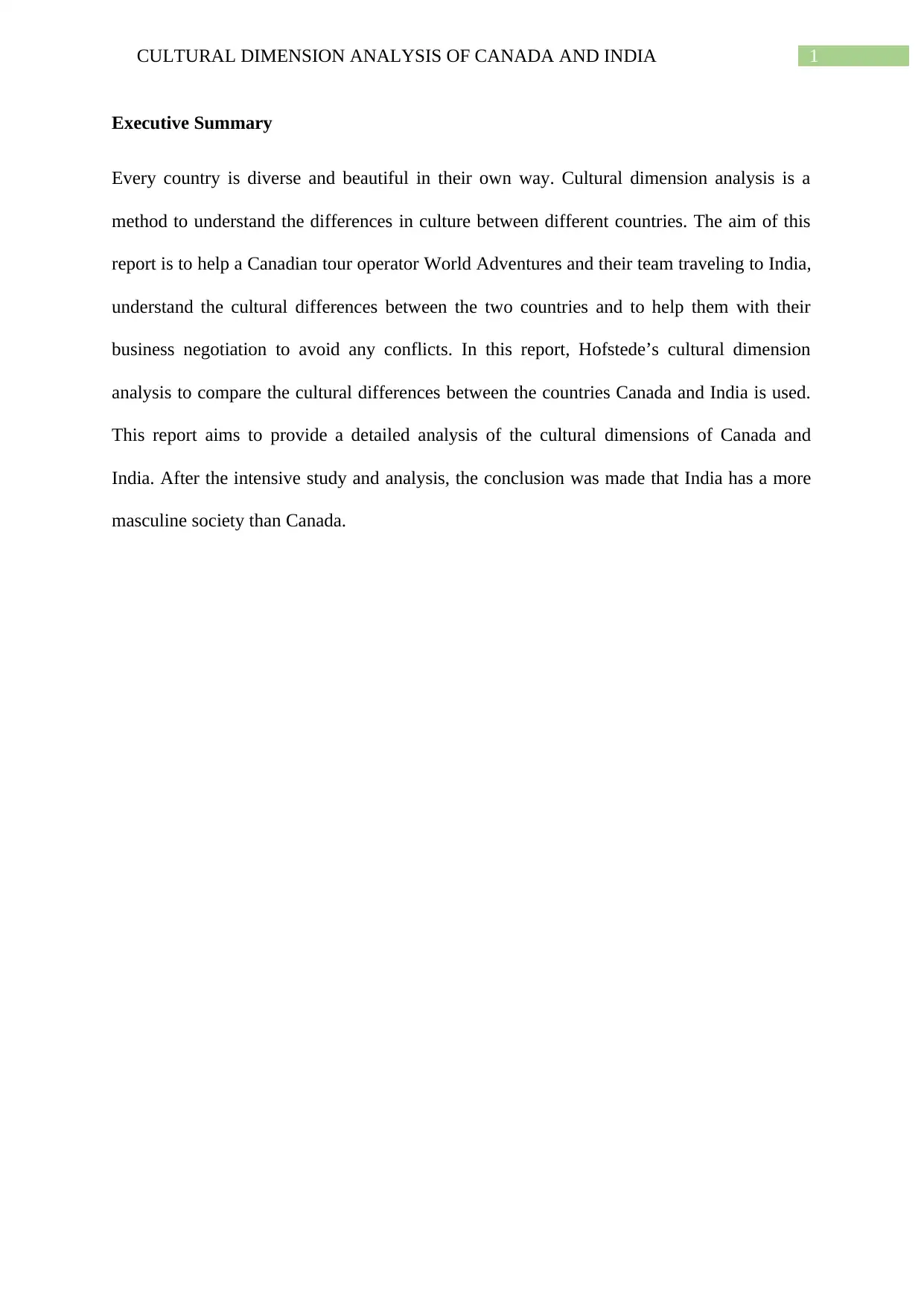
1CULTURAL DIMENSION ANALYSIS OF CANADA AND INDIA
Executive Summary
Every country is diverse and beautiful in their own way. Cultural dimension analysis is a
method to understand the differences in culture between different countries. The aim of this
report is to help a Canadian tour operator World Adventures and their team traveling to India,
understand the cultural differences between the two countries and to help them with their
business negotiation to avoid any conflicts. In this report, Hofstede’s cultural dimension
analysis to compare the cultural differences between the countries Canada and India is used.
This report aims to provide a detailed analysis of the cultural dimensions of Canada and
India. After the intensive study and analysis, the conclusion was made that India has a more
masculine society than Canada.
Executive Summary
Every country is diverse and beautiful in their own way. Cultural dimension analysis is a
method to understand the differences in culture between different countries. The aim of this
report is to help a Canadian tour operator World Adventures and their team traveling to India,
understand the cultural differences between the two countries and to help them with their
business negotiation to avoid any conflicts. In this report, Hofstede’s cultural dimension
analysis to compare the cultural differences between the countries Canada and India is used.
This report aims to provide a detailed analysis of the cultural dimensions of Canada and
India. After the intensive study and analysis, the conclusion was made that India has a more
masculine society than Canada.
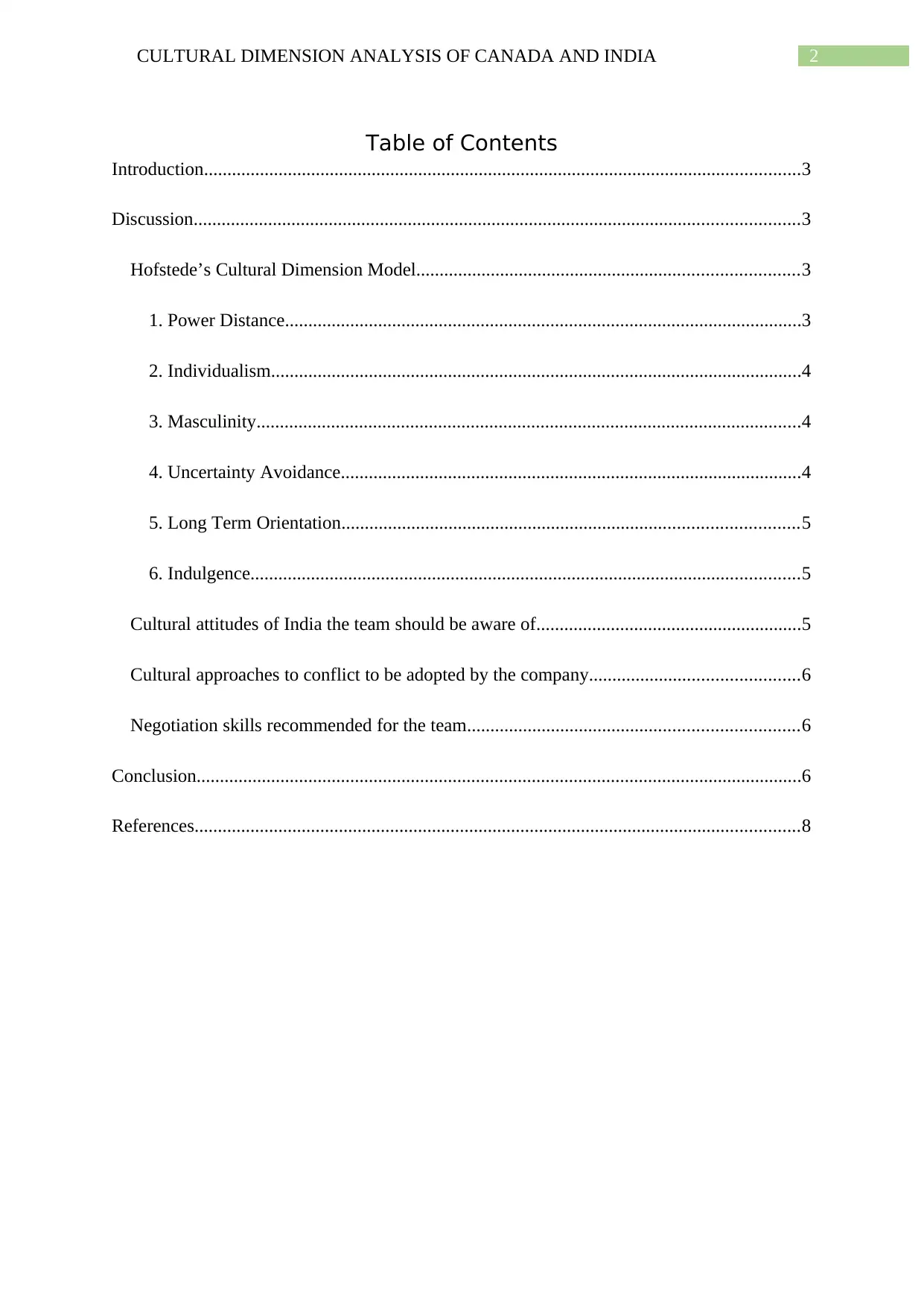
2CULTURAL DIMENSION ANALYSIS OF CANADA AND INDIA
Table of Contents
Introduction................................................................................................................................3
Discussion..................................................................................................................................3
Hofstede’s Cultural Dimension Model..................................................................................3
1. Power Distance...............................................................................................................3
2. Individualism..................................................................................................................4
3. Masculinity.....................................................................................................................4
4. Uncertainty Avoidance...................................................................................................4
5. Long Term Orientation..................................................................................................5
6. Indulgence......................................................................................................................5
Cultural attitudes of India the team should be aware of.........................................................5
Cultural approaches to conflict to be adopted by the company.............................................6
Negotiation skills recommended for the team.......................................................................6
Conclusion..................................................................................................................................6
References..................................................................................................................................8
Table of Contents
Introduction................................................................................................................................3
Discussion..................................................................................................................................3
Hofstede’s Cultural Dimension Model..................................................................................3
1. Power Distance...............................................................................................................3
2. Individualism..................................................................................................................4
3. Masculinity.....................................................................................................................4
4. Uncertainty Avoidance...................................................................................................4
5. Long Term Orientation..................................................................................................5
6. Indulgence......................................................................................................................5
Cultural attitudes of India the team should be aware of.........................................................5
Cultural approaches to conflict to be adopted by the company.............................................6
Negotiation skills recommended for the team.......................................................................6
Conclusion..................................................................................................................................6
References..................................................................................................................................8
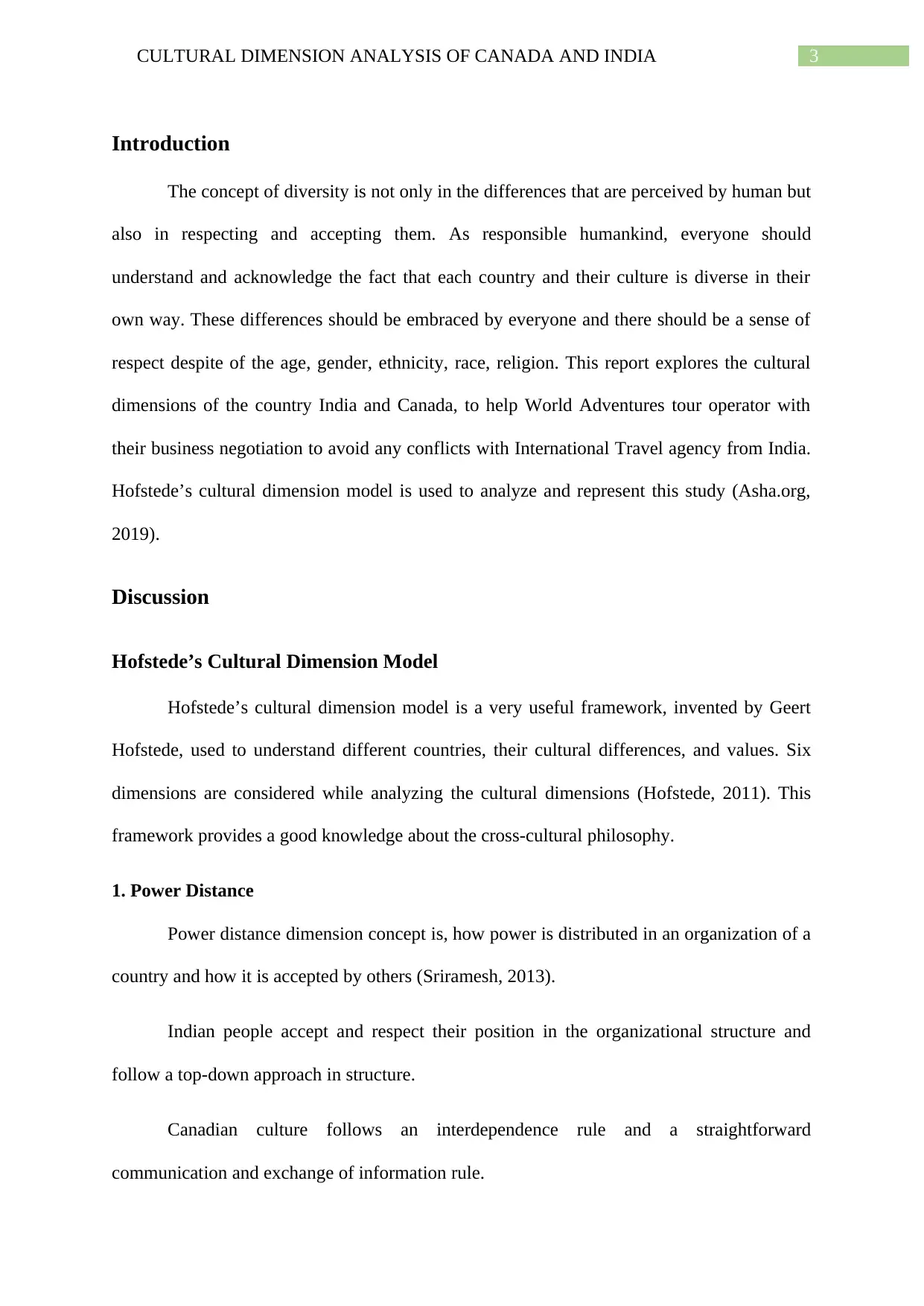
3CULTURAL DIMENSION ANALYSIS OF CANADA AND INDIA
Introduction
The concept of diversity is not only in the differences that are perceived by human but
also in respecting and accepting them. As responsible humankind, everyone should
understand and acknowledge the fact that each country and their culture is diverse in their
own way. These differences should be embraced by everyone and there should be a sense of
respect despite of the age, gender, ethnicity, race, religion. This report explores the cultural
dimensions of the country India and Canada, to help World Adventures tour operator with
their business negotiation to avoid any conflicts with International Travel agency from India.
Hofstede’s cultural dimension model is used to analyze and represent this study (Asha.org,
2019).
Discussion
Hofstede’s Cultural Dimension Model
Hofstede’s cultural dimension model is a very useful framework, invented by Geert
Hofstede, used to understand different countries, their cultural differences, and values. Six
dimensions are considered while analyzing the cultural dimensions (Hofstede, 2011). This
framework provides a good knowledge about the cross-cultural philosophy.
1. Power Distance
Power distance dimension concept is, how power is distributed in an organization of a
country and how it is accepted by others (Sriramesh, 2013).
Indian people accept and respect their position in the organizational structure and
follow a top-down approach in structure.
Canadian culture follows an interdependence rule and a straightforward
communication and exchange of information rule.
Introduction
The concept of diversity is not only in the differences that are perceived by human but
also in respecting and accepting them. As responsible humankind, everyone should
understand and acknowledge the fact that each country and their culture is diverse in their
own way. These differences should be embraced by everyone and there should be a sense of
respect despite of the age, gender, ethnicity, race, religion. This report explores the cultural
dimensions of the country India and Canada, to help World Adventures tour operator with
their business negotiation to avoid any conflicts with International Travel agency from India.
Hofstede’s cultural dimension model is used to analyze and represent this study (Asha.org,
2019).
Discussion
Hofstede’s Cultural Dimension Model
Hofstede’s cultural dimension model is a very useful framework, invented by Geert
Hofstede, used to understand different countries, their cultural differences, and values. Six
dimensions are considered while analyzing the cultural dimensions (Hofstede, 2011). This
framework provides a good knowledge about the cross-cultural philosophy.
1. Power Distance
Power distance dimension concept is, how power is distributed in an organization of a
country and how it is accepted by others (Sriramesh, 2013).
Indian people accept and respect their position in the organizational structure and
follow a top-down approach in structure.
Canadian culture follows an interdependence rule and a straightforward
communication and exchange of information rule.
Paraphrase This Document
Need a fresh take? Get an instant paraphrase of this document with our AI Paraphraser
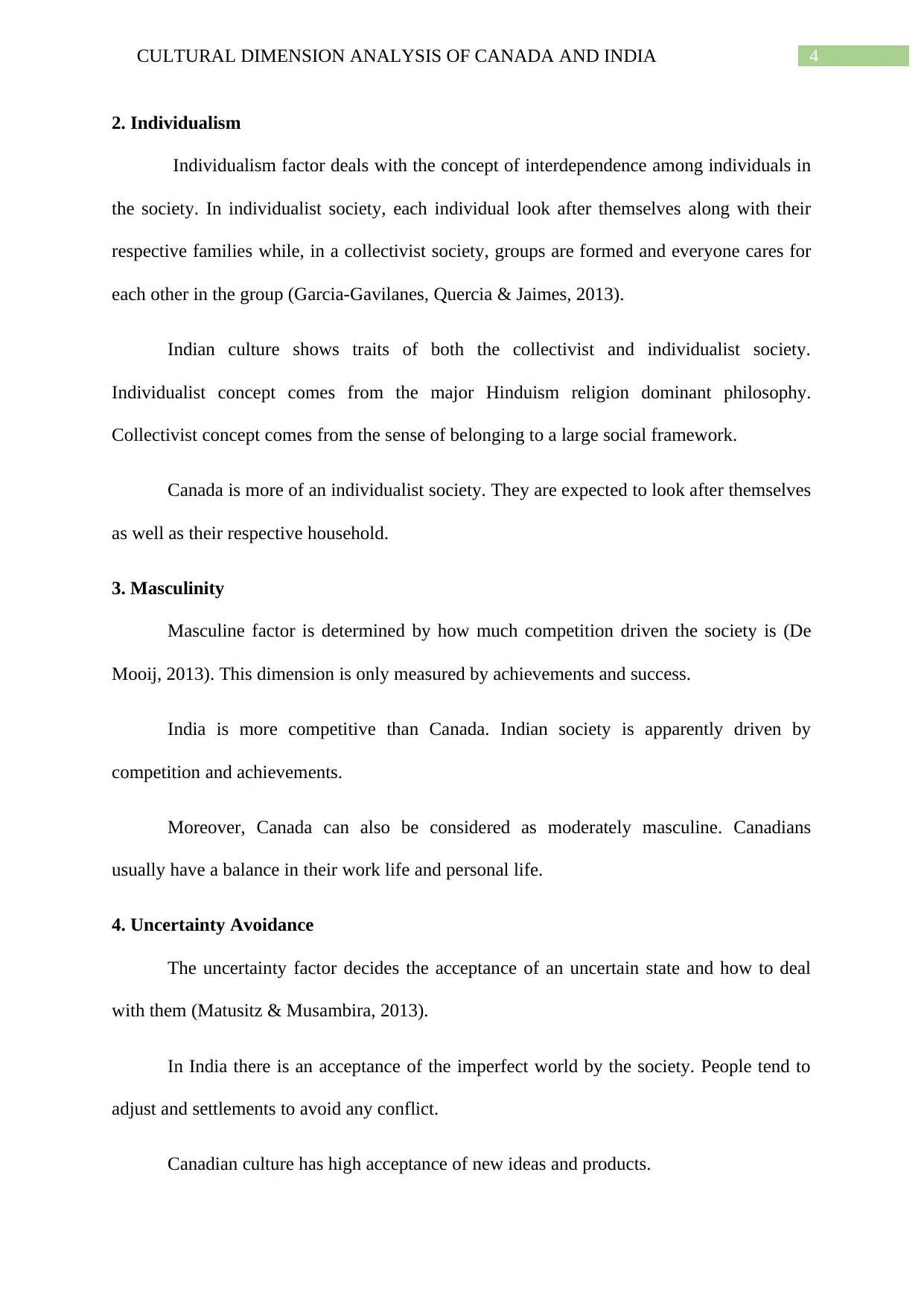
4CULTURAL DIMENSION ANALYSIS OF CANADA AND INDIA
2. Individualism
Individualism factor deals with the concept of interdependence among individuals in
the society. In individualist society, each individual look after themselves along with their
respective families while, in a collectivist society, groups are formed and everyone cares for
each other in the group (Garcia-Gavilanes, Quercia & Jaimes, 2013).
Indian culture shows traits of both the collectivist and individualist society.
Individualist concept comes from the major Hinduism religion dominant philosophy.
Collectivist concept comes from the sense of belonging to a large social framework.
Canada is more of an individualist society. They are expected to look after themselves
as well as their respective household.
3. Masculinity
Masculine factor is determined by how much competition driven the society is (De
Mooij, 2013). This dimension is only measured by achievements and success.
India is more competitive than Canada. Indian society is apparently driven by
competition and achievements.
Moreover, Canada can also be considered as moderately masculine. Canadians
usually have a balance in their work life and personal life.
4. Uncertainty Avoidance
The uncertainty factor decides the acceptance of an uncertain state and how to deal
with them (Matusitz & Musambira, 2013).
In India there is an acceptance of the imperfect world by the society. People tend to
adjust and settlements to avoid any conflict.
Canadian culture has high acceptance of new ideas and products.
2. Individualism
Individualism factor deals with the concept of interdependence among individuals in
the society. In individualist society, each individual look after themselves along with their
respective families while, in a collectivist society, groups are formed and everyone cares for
each other in the group (Garcia-Gavilanes, Quercia & Jaimes, 2013).
Indian culture shows traits of both the collectivist and individualist society.
Individualist concept comes from the major Hinduism religion dominant philosophy.
Collectivist concept comes from the sense of belonging to a large social framework.
Canada is more of an individualist society. They are expected to look after themselves
as well as their respective household.
3. Masculinity
Masculine factor is determined by how much competition driven the society is (De
Mooij, 2013). This dimension is only measured by achievements and success.
India is more competitive than Canada. Indian society is apparently driven by
competition and achievements.
Moreover, Canada can also be considered as moderately masculine. Canadians
usually have a balance in their work life and personal life.
4. Uncertainty Avoidance
The uncertainty factor decides the acceptance of an uncertain state and how to deal
with them (Matusitz & Musambira, 2013).
In India there is an acceptance of the imperfect world by the society. People tend to
adjust and settlements to avoid any conflict.
Canadian culture has high acceptance of new ideas and products.

5CULTURAL DIMENSION ANALYSIS OF CANADA AND INDIA
5. Long Term Orientation
This particular dimension deals with the preservation of the past links of the society
and culture and using them while dealing with the present problems (Venaik, Zhu & Brewer,
2013).
India encourages the belief of karma. India has high tolerance of religious view and it
is believed that, there are many truths and the acceptance depends on the suitor.
Canada has a normative society where people show great respect for their tradition.
6. Indulgence
This dimension is measured as the extent of a person’s control of their desires and
impulses (Kedmenec & Strašek, 2017). Weak control of desire is known as “indulgence”
whereas, strong control of desire is known as “restraint”.
India has a restraint culture. These types of societies believe that they are bound to
follow the social norms.
Canada has an indulgent culture, with an optimistic society and high degree of leisure
time and spending habits.
Cultural attitudes of India the team should be aware of
India is a land of spiritual beliefs with the dominating Hindu culture. Religious
practices are very important in daily life. Family values are given respect throughout India
and is a patriarchal society. English is the major language used for communication in
business. Hinduism promotes yoga and medication for self-discipline. Cows are considered
as the most sacred animals. India follows a cast structure with mainly four groups the
Brahmins, Kshatriyas, Vaishyas and Shudras. Inter-caste marriages are forbidden but in urban
areas are now common. India has one of the fastest growing economies in the world with
5. Long Term Orientation
This particular dimension deals with the preservation of the past links of the society
and culture and using them while dealing with the present problems (Venaik, Zhu & Brewer,
2013).
India encourages the belief of karma. India has high tolerance of religious view and it
is believed that, there are many truths and the acceptance depends on the suitor.
Canada has a normative society where people show great respect for their tradition.
6. Indulgence
This dimension is measured as the extent of a person’s control of their desires and
impulses (Kedmenec & Strašek, 2017). Weak control of desire is known as “indulgence”
whereas, strong control of desire is known as “restraint”.
India has a restraint culture. These types of societies believe that they are bound to
follow the social norms.
Canada has an indulgent culture, with an optimistic society and high degree of leisure
time and spending habits.
Cultural attitudes of India the team should be aware of
India is a land of spiritual beliefs with the dominating Hindu culture. Religious
practices are very important in daily life. Family values are given respect throughout India
and is a patriarchal society. English is the major language used for communication in
business. Hinduism promotes yoga and medication for self-discipline. Cows are considered
as the most sacred animals. India follows a cast structure with mainly four groups the
Brahmins, Kshatriyas, Vaishyas and Shudras. Inter-caste marriages are forbidden but in urban
areas are now common. India has one of the fastest growing economies in the world with
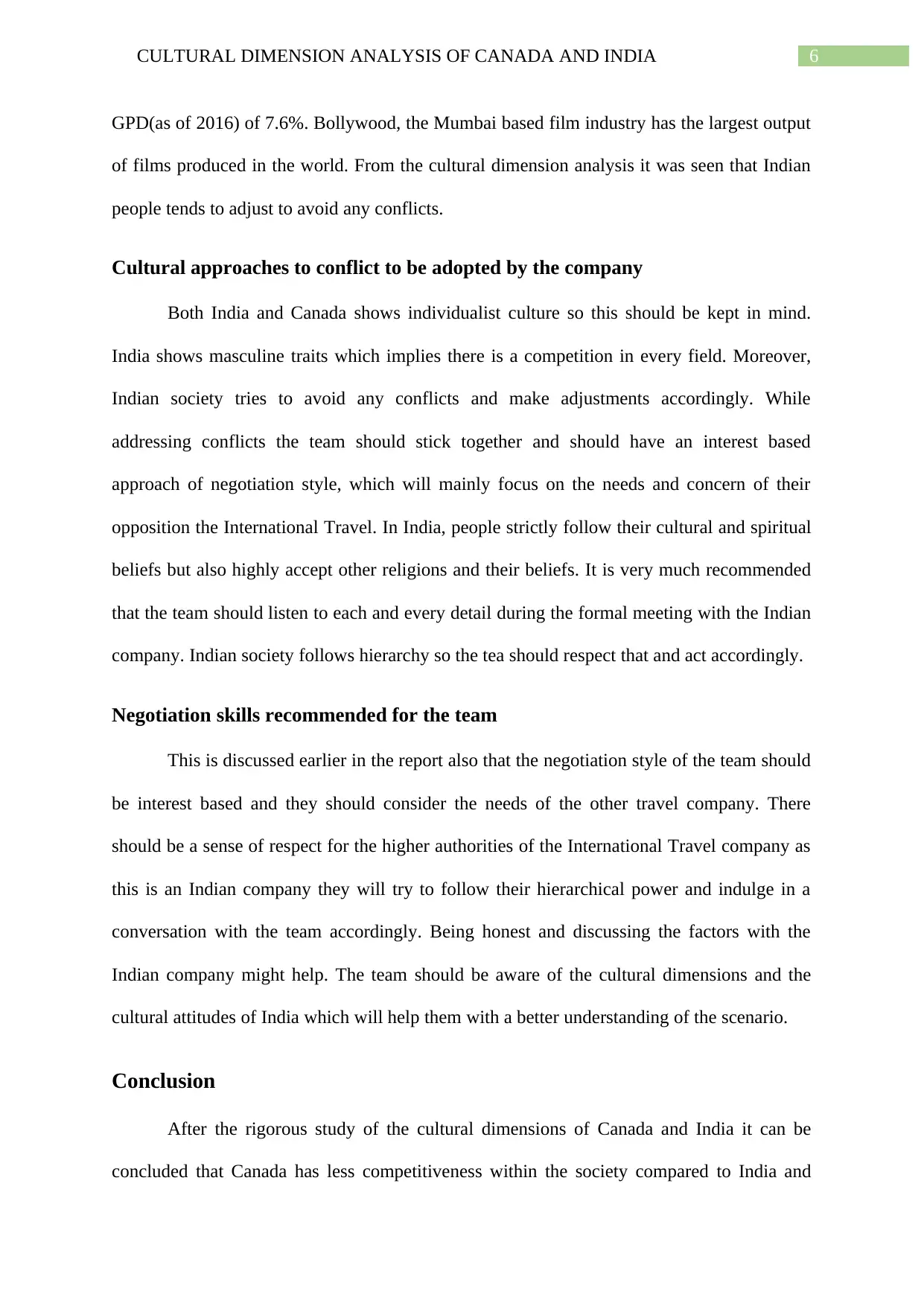
6CULTURAL DIMENSION ANALYSIS OF CANADA AND INDIA
GPD(as of 2016) of 7.6%. Bollywood, the Mumbai based film industry has the largest output
of films produced in the world. From the cultural dimension analysis it was seen that Indian
people tends to adjust to avoid any conflicts.
Cultural approaches to conflict to be adopted by the company
Both India and Canada shows individualist culture so this should be kept in mind.
India shows masculine traits which implies there is a competition in every field. Moreover,
Indian society tries to avoid any conflicts and make adjustments accordingly. While
addressing conflicts the team should stick together and should have an interest based
approach of negotiation style, which will mainly focus on the needs and concern of their
opposition the International Travel. In India, people strictly follow their cultural and spiritual
beliefs but also highly accept other religions and their beliefs. It is very much recommended
that the team should listen to each and every detail during the formal meeting with the Indian
company. Indian society follows hierarchy so the tea should respect that and act accordingly.
Negotiation skills recommended for the team
This is discussed earlier in the report also that the negotiation style of the team should
be interest based and they should consider the needs of the other travel company. There
should be a sense of respect for the higher authorities of the International Travel company as
this is an Indian company they will try to follow their hierarchical power and indulge in a
conversation with the team accordingly. Being honest and discussing the factors with the
Indian company might help. The team should be aware of the cultural dimensions and the
cultural attitudes of India which will help them with a better understanding of the scenario.
Conclusion
After the rigorous study of the cultural dimensions of Canada and India it can be
concluded that Canada has less competitiveness within the society compared to India and
GPD(as of 2016) of 7.6%. Bollywood, the Mumbai based film industry has the largest output
of films produced in the world. From the cultural dimension analysis it was seen that Indian
people tends to adjust to avoid any conflicts.
Cultural approaches to conflict to be adopted by the company
Both India and Canada shows individualist culture so this should be kept in mind.
India shows masculine traits which implies there is a competition in every field. Moreover,
Indian society tries to avoid any conflicts and make adjustments accordingly. While
addressing conflicts the team should stick together and should have an interest based
approach of negotiation style, which will mainly focus on the needs and concern of their
opposition the International Travel. In India, people strictly follow their cultural and spiritual
beliefs but also highly accept other religions and their beliefs. It is very much recommended
that the team should listen to each and every detail during the formal meeting with the Indian
company. Indian society follows hierarchy so the tea should respect that and act accordingly.
Negotiation skills recommended for the team
This is discussed earlier in the report also that the negotiation style of the team should
be interest based and they should consider the needs of the other travel company. There
should be a sense of respect for the higher authorities of the International Travel company as
this is an Indian company they will try to follow their hierarchical power and indulge in a
conversation with the team accordingly. Being honest and discussing the factors with the
Indian company might help. The team should be aware of the cultural dimensions and the
cultural attitudes of India which will help them with a better understanding of the scenario.
Conclusion
After the rigorous study of the cultural dimensions of Canada and India it can be
concluded that Canada has less competitiveness within the society compared to India and
Secure Best Marks with AI Grader
Need help grading? Try our AI Grader for instant feedback on your assignments.
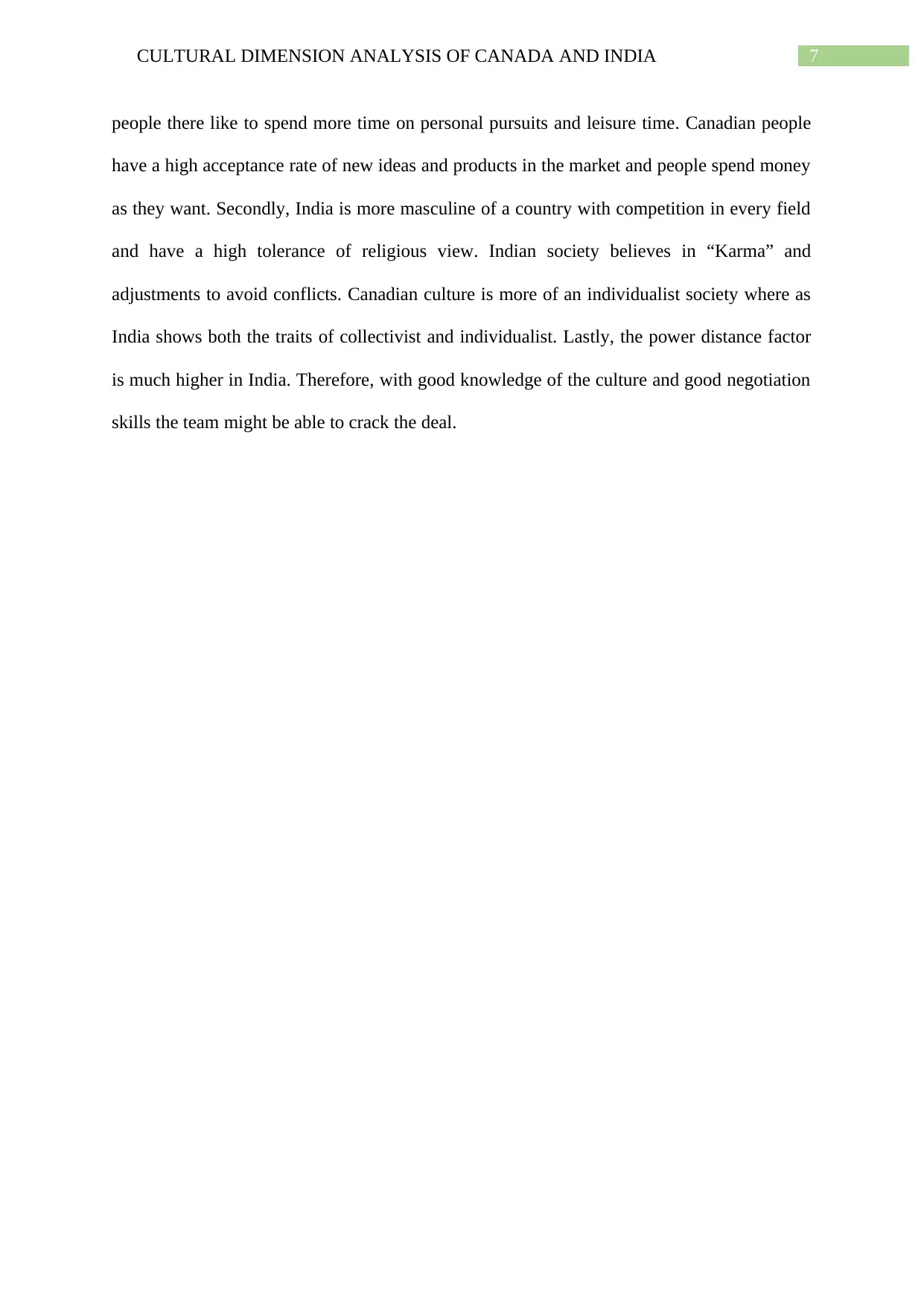
7CULTURAL DIMENSION ANALYSIS OF CANADA AND INDIA
people there like to spend more time on personal pursuits and leisure time. Canadian people
have a high acceptance rate of new ideas and products in the market and people spend money
as they want. Secondly, India is more masculine of a country with competition in every field
and have a high tolerance of religious view. Indian society believes in “Karma” and
adjustments to avoid conflicts. Canadian culture is more of an individualist society where as
India shows both the traits of collectivist and individualist. Lastly, the power distance factor
is much higher in India. Therefore, with good knowledge of the culture and good negotiation
skills the team might be able to crack the deal.
people there like to spend more time on personal pursuits and leisure time. Canadian people
have a high acceptance rate of new ideas and products in the market and people spend money
as they want. Secondly, India is more masculine of a country with competition in every field
and have a high tolerance of religious view. Indian society believes in “Karma” and
adjustments to avoid conflicts. Canadian culture is more of an individualist society where as
India shows both the traits of collectivist and individualist. Lastly, the power distance factor
is much higher in India. Therefore, with good knowledge of the culture and good negotiation
skills the team might be able to crack the deal.
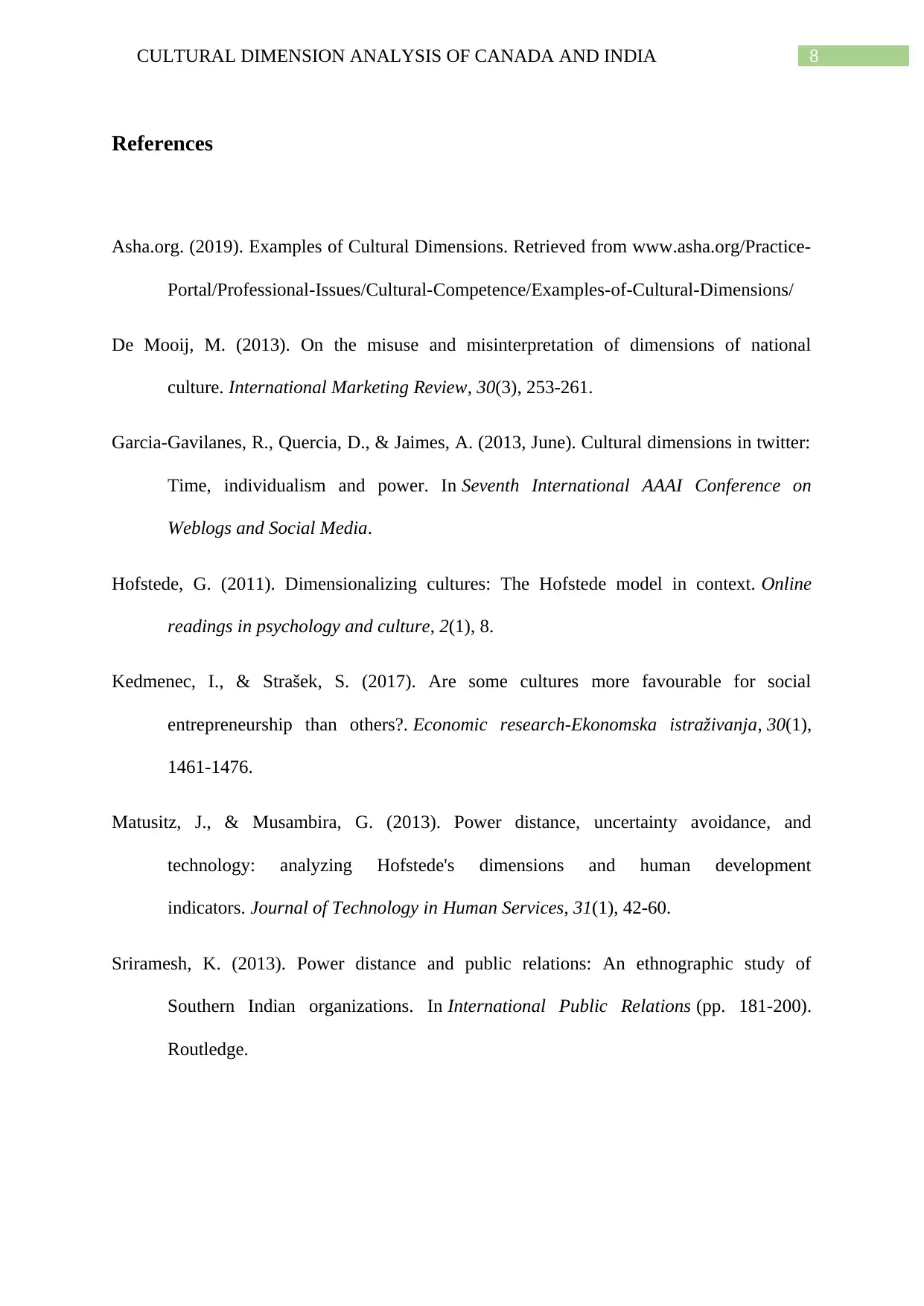
8CULTURAL DIMENSION ANALYSIS OF CANADA AND INDIA
References
Asha.org. (2019). Examples of Cultural Dimensions. Retrieved from www.asha.org/Practice-
Portal/Professional-Issues/Cultural-Competence/Examples-of-Cultural-Dimensions/
De Mooij, M. (2013). On the misuse and misinterpretation of dimensions of national
culture. International Marketing Review, 30(3), 253-261.
Garcia-Gavilanes, R., Quercia, D., & Jaimes, A. (2013, June). Cultural dimensions in twitter:
Time, individualism and power. In Seventh International AAAI Conference on
Weblogs and Social Media.
Hofstede, G. (2011). Dimensionalizing cultures: The Hofstede model in context. Online
readings in psychology and culture, 2(1), 8.
Kedmenec, I., & Strašek, S. (2017). Are some cultures more favourable for social
entrepreneurship than others?. Economic research-Ekonomska istraživanja, 30(1),
1461-1476.
Matusitz, J., & Musambira, G. (2013). Power distance, uncertainty avoidance, and
technology: analyzing Hofstede's dimensions and human development
indicators. Journal of Technology in Human Services, 31(1), 42-60.
Sriramesh, K. (2013). Power distance and public relations: An ethnographic study of
Southern Indian organizations. In International Public Relations (pp. 181-200).
Routledge.
References
Asha.org. (2019). Examples of Cultural Dimensions. Retrieved from www.asha.org/Practice-
Portal/Professional-Issues/Cultural-Competence/Examples-of-Cultural-Dimensions/
De Mooij, M. (2013). On the misuse and misinterpretation of dimensions of national
culture. International Marketing Review, 30(3), 253-261.
Garcia-Gavilanes, R., Quercia, D., & Jaimes, A. (2013, June). Cultural dimensions in twitter:
Time, individualism and power. In Seventh International AAAI Conference on
Weblogs and Social Media.
Hofstede, G. (2011). Dimensionalizing cultures: The Hofstede model in context. Online
readings in psychology and culture, 2(1), 8.
Kedmenec, I., & Strašek, S. (2017). Are some cultures more favourable for social
entrepreneurship than others?. Economic research-Ekonomska istraživanja, 30(1),
1461-1476.
Matusitz, J., & Musambira, G. (2013). Power distance, uncertainty avoidance, and
technology: analyzing Hofstede's dimensions and human development
indicators. Journal of Technology in Human Services, 31(1), 42-60.
Sriramesh, K. (2013). Power distance and public relations: An ethnographic study of
Southern Indian organizations. In International Public Relations (pp. 181-200).
Routledge.
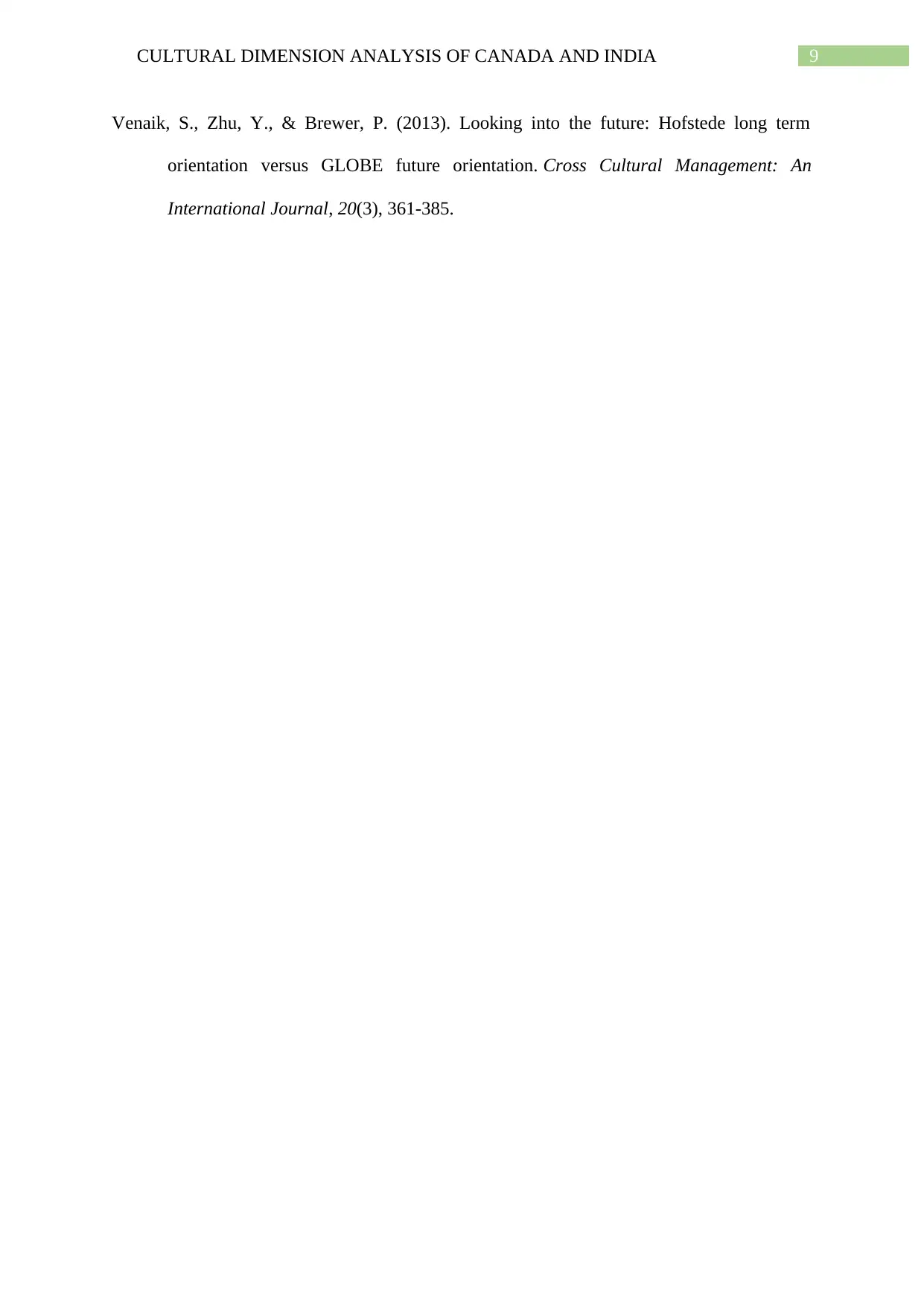
9CULTURAL DIMENSION ANALYSIS OF CANADA AND INDIA
Venaik, S., Zhu, Y., & Brewer, P. (2013). Looking into the future: Hofstede long term
orientation versus GLOBE future orientation. Cross Cultural Management: An
International Journal, 20(3), 361-385.
Venaik, S., Zhu, Y., & Brewer, P. (2013). Looking into the future: Hofstede long term
orientation versus GLOBE future orientation. Cross Cultural Management: An
International Journal, 20(3), 361-385.
1 out of 10
![[object Object]](/_next/static/media/star-bottom.7253800d.svg)




